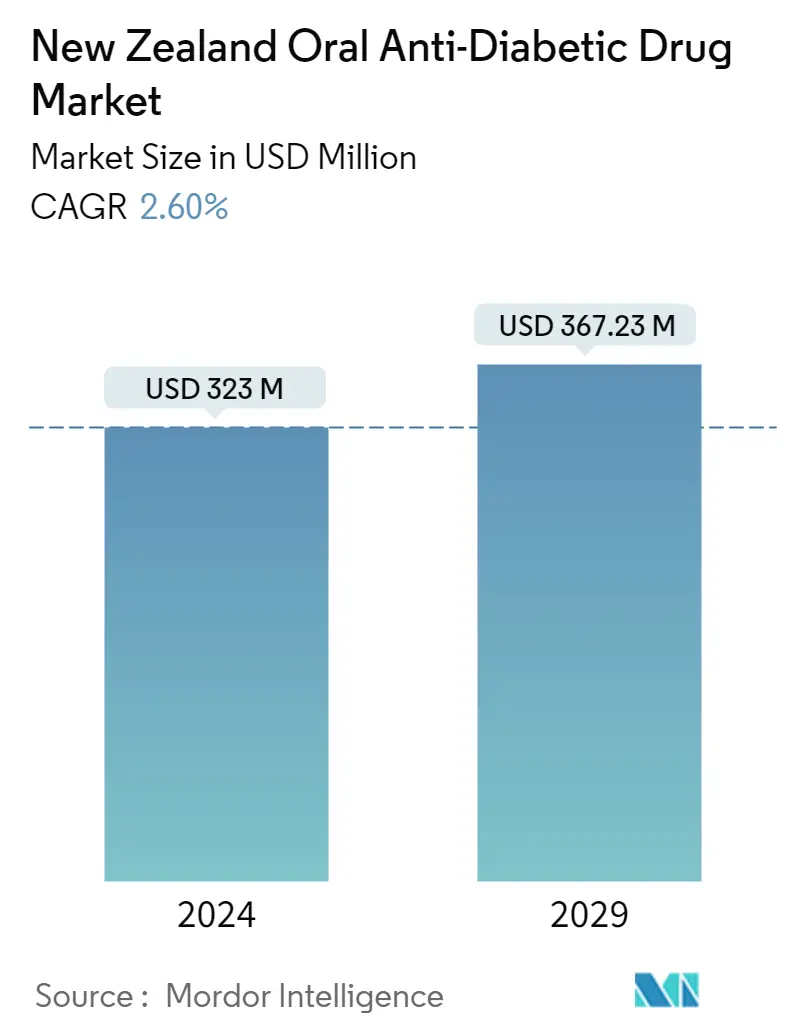Market Size of New Zealand Oral Anti-Diabetic Drug Industry

| Study Period | 2019 - 2029 |
| Base Year For Estimation | 2023 |
| Forecast Data Period | 2024 - 2029 |
| Market Size (2024) | USD 323.00 Million |
| Market Size (2029) | USD 367.23 Million |
| CAGR (2024 - 2029) | 2.60 % |
Major Players
*Disclaimer: Major Players sorted in no particular order |
New Zealand Oral Anti-Diabetic Drug Market Analysis
The New Zealand Oral Anti-Diabetic Drug Market size is estimated at USD 323 million in 2024, and is expected to reach USD 367.23 million by 2029, growing at a CAGR of 2.60% during the forecast period (2024-2029).
The likelihood of having type 1 diabetes increased when COVID-19 was discovered. Young pediatric patients and older adult patients with COVID-19 had the highest risk. Patients with type 1 diabetes were more likely to contract the virus and experience potentially catastrophic side effects such as diabetic ketoacidosis. Patients required access to diabetes services and get high-quality clinical care, which includes diabetes screening, education, monitoring of complications, and control. The hormone insulin encourages the liver, muscle, and fat cells to absorb glucose from the blood in order to regulate blood sugar levels. It facilitates the absorption of glucose for cellular energy utilization by cells. When the pancreas is unable to create enough insulin, type 1 diabetes develops. Diabetes is frequently thought of as a condition linked to lifestyle. Because of the growing world population, the disease's prevalence has substantially increased over time. Insulin is necessary for everyone with Type 1 diabetes and 10% to 25% of people with Type 2 diabetes or over 100 million people globally. Despite the fact that insulin has been used to treat diabetes for more than 90 years, more than half of the individuals in New Zealand who require it still do not have access to it or can afford it. Insulin As people with type-1 diabetes cannot produce insulin on their own. They require medications and delivery methods. Those with type-2 diabetes also require insulin, especially if they are having problems managing their condition.
New Zealand Oral Anti-Diabetic Drug Industry Segmentation
Orally administered antihyperglycemic drugs reduce blood glucose levels. They are often used in type 2 diabetes care. New Zealand Oral Anti-Diabetic Drug Market is set to witness a CAGR of more than 2% during the forecast period. New Zealand Oral Anti-Diabetic Drug Market is segmented into drugs (Biguanides, Alpha-glucosidase inhibitors, Dopamine-D2 receptor agonists, Sodium-glucose Cotransport-2 (SGLT-2) inhibitor, Dipeptidyl Peptidase-4 (DPP-4) Inhibitors, Sulfonylureas, and Meglitinides). The report offers the value (in USD million) and volume (in Units million) for the above segments.
| Oral Anti-diabetic drugs (Value and Volume, 2017 - 2028) | ||||||
| ||||||
| ||||||
| ||||||
| ||||||
| ||||||
| ||||||
|
New Zealand Oral Anti-Diabetic Drug Market Size Summary
The New Zealand oral anti-diabetic drug market is experiencing a steady growth trajectory, driven by the increasing prevalence of diabetes and the need for effective management solutions. The market is characterized by a consolidated landscape, with major global players such as Eli Lilly, AstraZeneca, Sanofi, and Janssen Pharmaceuticals leading the charge. These companies are focusing on innovative drug developments to cater to the rising demand for diabetes management. The market dynamics are influenced by the growing incidence of type 1 and type 2 diabetes, exacerbated by lifestyle factors and the COVID-19 pandemic, which has highlighted the importance of accessible diabetes care and treatment options.
The market's expansion is further supported by advancements in drug therapies, including Sodium-glucose Cotransport-2 (SGLT-2) inhibitors and GLP-1-based medications, which play a crucial role in glucose regulation and insulin secretion. Despite the availability of these treatments, access and affordability remain challenges for a significant portion of the population in New Zealand. The healthcare system, comprising primary and secondary care services, strives to address these issues, although disparities exist, particularly among Pacific, Māori, and South Asian communities. Initiatives like Pharmac's funding approvals and awareness campaigns aim to improve access to essential medications for those in need, underscoring the ongoing efforts to enhance diabetes care across the country.
New Zealand Oral Anti-Diabetic Drug Market Size - Table of Contents
-
1. MARKET DYNAMICS
-
1.1 Market Overview
-
1.2 Market Drivers
-
1.3 Market Restraints
-
1.4 Porter's Five Forces Analysis
-
1.4.1 Bargaining Power of Suppliers
-
1.4.2 Bargaining Power of Consumers
-
1.4.3 Threat of New Entrants
-
1.4.4 Threat of Substitute Products and Services
-
1.4.5 Intensity of Competitive Rivalry
-
-
-
2. MARKET SEGMENTATION
-
2.1 Oral Anti-diabetic drugs (Value and Volume, 2017 - 2028)
-
2.1.1 Biguanides
-
2.1.1.1 Metformin
-
-
2.1.2 Alpha-Glucosidase Inhibitors
-
2.1.2.1 Alpha-Glucosidase Inhibitors
-
-
2.1.3 Dopamine D2 receptor agonist
-
2.1.3.1 Bromocriptin
-
-
2.1.4 SGLT-2 inhibitors
-
2.1.4.1 Invokana (Canagliflozin)
-
2.1.4.2 Jardiance (Empagliflozin)
-
2.1.4.3 Farxiga/Forxiga (Dapagliflozin)
-
2.1.4.4 Suglat (Ipragliflozin)
-
-
2.1.5 DPP-4 inhibitors
-
2.1.5.1 Onglyza (Saxagliptin)
-
2.1.5.2 Tradjenta (Linagliptin)
-
2.1.5.3 Vipidia/Nesina(Alogliptin)
-
2.1.5.4 Galvus (Vildagliptin)
-
-
2.1.6 Sulfonylureas
-
2.1.6.1 Sulfonylureas
-
-
2.1.7 Meglitinides
-
2.1.7.1 Meglitinides
-
-
-
New Zealand Oral Anti-Diabetic Drug Market Size FAQs
How big is the New Zealand Oral Anti-Diabetic Drug Market?
The New Zealand Oral Anti-Diabetic Drug Market size is expected to reach USD 323.00 million in 2024 and grow at a CAGR of 2.60% to reach USD 367.23 million by 2029.
What is the current New Zealand Oral Anti-Diabetic Drug Market size?
In 2024, the New Zealand Oral Anti-Diabetic Drug Market size is expected to reach USD 323.00 million.

